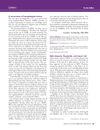The document concludes that measuring hair density, shaft diameter, growth rate, and anagen:telogen ratio is important for assessing hair growth treatments.
Melatonin helps hair grow.
May 2012 in “International Journal of Dermatology and Venereology” New treatments are improving options for female hair loss.
July 2013 in “International Journal of Dermatology and Venereology” September 2018 in “Chinese Journal of Dermatology” Angiogenin may help treat hair loss by reducing certain proteins in hair cells.
Certain genetic markers on chromosome 20 are linked to hair loss in the Han Chinese from Yunnan.
February 2020 in “Int J Biologicals” Super-activated platelet lysate significantly promotes hair regrowth in mice with androgenetic alopecia.
August 2021 in “Chinese journal of burns” Combining FUE with rb-bFGF and minoxidil is more effective and has fewer side effects than FUE alone for treating hair loss.
 February 2012 in “Community oncology”
February 2012 in “Community oncology” The document concludes that accurately identifying leukemia types is crucial, and the risks of cancer from finasteride need careful evaluation against its benefits.
1 citations,
May 2010 in “Chinese journal of plastic surgery” Melatonin might help treat thick scars.
Weight loss and low folic acid levels after sleeve gastrectomy can predict hair loss severity.
1 citations,
January 2017 in “Deleted Journal” Orthosiphon stamineus extract can significantly boost hair growth and cell proliferation in hair loss patients.
October 2017 in “Chinese Journal of Dermatology”  2 citations,
January 2017 in “Clinical and medical investigations”
2 citations,
January 2017 in “Clinical and medical investigations” Herbal lotions are effective for severe hair loss, with a 64.8% success rate, but relapse is common and long-term management requires allergen control and possible corticosteroid use.
 437 citations,
August 2014 in “Cell metabolism”
437 citations,
August 2014 in “Cell metabolism” Turning white fat into brown-like fat could help fight obesity and type 2 diabetes.
August 2018 in “Chinese journal of plastic surgery” Buccal mucosa grafts work well for urethroplasty in rabbits.
 December 2017 in “Chin J Cell Stem Cell (Electronic Edition)”
December 2017 in “Chin J Cell Stem Cell (Electronic Edition)” Hair follicle stem cells help skin wounds heal faster.
January 2010 in “International Journal of Dermatology and Venereology” Dermal papilla cells play a key role in hair loss by responding to androgens.
 March 2014 in “Chinese Journal of Dermatology”
March 2014 in “Chinese Journal of Dermatology” Hair loss in androgenic alopecia patients is linked to changes in certain genes that control cell growth and death.
 December 2016 in “Int J Genet”
December 2016 in “Int J Genet” Male pattern baldness is partly caused by specific genes, but most genetic factors are still unknown.
A specific gene mutation causes monilethrix in this family, and minoxidil treatment improves hair condition.
January 2017 in “Deleted Journal” Hair transplantation surgery now offers natural, lasting, and safe results.
 September 2022 in “PubMed”
September 2022 in “PubMed” Collagen type XVII α1 decreases with age, leading to skin aging, but targeting microRNA-203b-3p may help maintain its levels and improve skin health.
 September 2009 in “International Journal of Dermatology and Venereology”
September 2009 in “International Journal of Dermatology and Venereology” Dermal papilla cells play a key role in hair growth and health.
JAK inhibitors show promise in treating moderate to severe alopecia areata.
222 citations,
August 2014 in “Cell Metabolism” Mitochondrial Complex I reduces inflammation and increases bone breakdown by affecting certain immune cells.
PRP is a safe, low-cost treatment used in dermatology for hair loss, skin rejuvenation, scar repair, and wound healing.
55 citations,
November 2010 in “Journal of Allergy and Clinical Immunology” The L412F variant of TLR3 is linked to skin infections, more viral infections, and autoimmune issues.
 September 2014 in “International Journal of Dermatology and Venereology”
September 2014 in “International Journal of Dermatology and Venereology” Certain histamine receptors (H2R, H3R, H4R) have unique roles in treating skin diseases, with H2R helping with chronic urticaria and other conditions, H3R providing pain relief and allergy benefits, and H4R reducing inflammation and itchiness.








